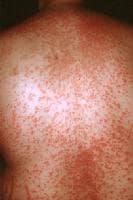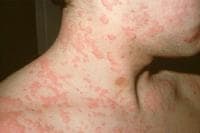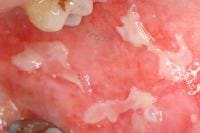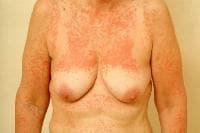Drug eruptions can mimic a variety of dermatoses. The morphologies are myriad and embrace morbilliform, urticarial, papulosquamous, pustular, and bullous. drugs may additionally lead to pruritus and dysesthesia without an obtrusive eruption. A drug-induced reaction will have to be thought to be in any patient who's taking medicines and who all at once develops a symmetric cutaneous eruption.
crucial replace: Drug patch exams can identify agents liable for severe cutaneous adversarial reactions
In a find out about of 134 patients with severe cutaneous adversarial drug reactions, Barbaud et al found that drug patch tests will be safely used to identify the accountable drug. Of the 134 patients, forty five had acute generalized exanthematous pustulosis (AGEP), 72 had drug reaction with eosinophilia and systemic signs (dress), and 17 had Stevens-Johnson syndrome (SJS)/toxic epidermal necrolysis (TEN). sure drug patch take a look at results were bought for sixty four% of the sufferers within the dress crew, 58% of these within the AGEP workforce, and 24% of these in the SJS/TEN crew; 1 AGEP affected person experienced relapse.[1]
indicators and symptoms
the first steps within the historical past are as follows:
evaluation the patient’s complete medicine checklist, together with prescription and over-the-counter drugsDocument any historical past of earlier hostile reactions to medicine or foodsConsider different etiologies (eg, viral exanthems and bacterial infections)notice any concurrent infections, metabolic problems, or immunocompromise
in addition, the following should be mentioned and unique:
Interval between introduction of a drug and onset of the eruptionRoute, dose, period, and frequency of drug administrationUse of parenterally administered medicine (extra more likely to cause anaphylaxis)Use of topically utilized drugs (more prone to result in delayed-kind hypersensitivity)Use of a couple of courses of remedy and extended administration (risk of allergic sensitization)Any improvement after drug withdrawal and any response with readministration
physical examination should handle medical options that can point out a extreme, probably existence-threatening drug response, together with the next:
Mucous membrane erosionsBlistersNikolsky signConfluent erythemaAngioedema and tongue swellingPalpable purpuraSkin necrosisLymphadenopathyHigh fever, dyspnea, or hypotension
it is important to savor the morphology and bodily options of drug eruptions, as follows:
AcneiformAcral erythema (erythrodysesthesia)AGEPDermatomyositislikeDRESSErythema multiforme (EM), together with EM minor, SJS, TEN, and SJS/TEN overlapErythema nodosumErythrodermaFixed drug eruptionsHypersensitivity syndromeLeukocytoclastic vasculitisLichenoidLupusMorbilliform or exanthematousPseudoporphyria[2] Serum sickness and serum sickness–likeSweet syndrome (acute febrile neutrophilic dermatosis)UrticariaVesiculobullous
See clinical Presentation for extra detail.
diagnosis
With gentle asymptomatic eruptions, the history and bodily examination are steadily enough for prognosis; with extreme or persistent eruptions, additional diagnostic testing could also be required, as follows:
BiopsyComplete blood rely (CBC) with differentialSerum chemistry research (particularly for electrolyte balance and indices of renal or hepatic operate in patients with extreme reactions) Antibody or immunoserology testsDirect cultures to research a major infectious etiology or secondary infectionUrinalysis, stool guaiac assessments, and chest radiography for vasculitisSkin prick or patch testing to substantiate the causative agent
See Workup for more detail.
management
rules of medical care are as follows:
the final word purpose is to identify and discontinue the offending medication if possiblePatients can on occasion continue to be treated thru morbilliform eruptions; nevertheless, all sufferers with extreme morbilliform eruptions must be monitored for mucous membrane lesions, blistering, and pores and skin sloughing remedy of a drug eruption is determined by the particular kind of reactionTherapy for exanthematous drug eruptions is supportive, involving the administration of oral antihistamines, topical steroids, and moisturizing lotions extreme reactions (eg, SJS, TEN, and hypersensitivity reactions) warrant medical institution admissionTEN is very best managed in a burn unit, and intravenous immunoglobulin (IVIG) may make stronger effects[3, 4, 5] Hypersensitivity syndrome, may just have to be treated with liver transplantation if the offending drug shouldn't be stopped in time; remedy with systemic corticosteroids has been recommended
for most drug eruptions, full restoration without any complications is expected; however, the next must be mentioned:
sufferers with exanthematous eruptions should expect mild desquamation because the rash resolvesPatients with hypersensitivity syndrome are vulnerable to changing into hypothyroid, on a regular basis inside the first four-12 weeks after the response The prognosis for sufferers with TEN is guarded; scarring, blindness, and death are that you can think of
See therapy and medication for extra element.
image library
 Stevens-Johnson syndrome. NextBackground
Stevens-Johnson syndrome. NextBackgroundDrug eruptions can mimic a wide range of dermatoses. The morphologies are myriad and embrace morbilliform (most common, see picture under), urticarial, papulosquamous, pustular, and bullous. medicines can also cause pruritus and dysesthesia with out an obtrusive eruption.
 Morbilliform drug eruption.
Morbilliform drug eruption.A drug-brought about reaction will have to be regarded as in any patient who's taking medicines and who suddenly develops a symmetric cutaneous eruption. drugs which can be known for inflicting cutaneous reactions embody antimicrobial sellers,[6] nonsteroidal anti-inflammatory drugs (NSAIDs), cytokines, chemotherapeutic sellers, anticonvulsants, and psychotropic marketers.
urged identification and withdrawal of the offending agent could assist limit the toxic effects associated with the drug. the decision to discontinue a potentially crucial drug frequently presents a dilemma.
PreviousNextPathophysiology
Drug eruptions may be divided into immunologically and nonimmunologically mediated reactions.
Immunologically mediated reactions
Coombs and Gell proposed four sorts of immunologically mediated reactions, as follows:
type I is immunoglobulin E (IgE)–established reactions, which lead to urticaria, angioedema, and anaphylaxis (see the picture under).
 Urticaria. kind II is cytotoxic reactions, which result in hemolysis and purpura (see the picture beneath).
Urticaria. kind II is cytotoxic reactions, which result in hemolysis and purpura (see the picture beneath). Oral ulcerations in a affected person receiving cytotoxic remedy. sort III is immune advanced reactions, which lead to vasculitis, serum sickness, and urticaria.sort IV is delayed-kind reactions with cell-mediated hypersensitivity, which result in contact dermatitis, exanthematous reactions, and photoallergic reactions.
Oral ulcerations in a affected person receiving cytotoxic remedy. sort III is immune advanced reactions, which lead to vasculitis, serum sickness, and urticaria.sort IV is delayed-kind reactions with cell-mediated hypersensitivity, which result in contact dermatitis, exanthematous reactions, and photoallergic reactions.Insulin and different proteins are related to kind I reactions. Penicillin, cephalosporins, sulfonamides, and rifampin are known to result in type II reactions. Quinine, salicylates, chlorpromazine, and sulfonamides can cause type III reactions. kind IV reactions, the most typical mechanism of drug eruptions, are steadily encountered in instances of contact hypersensitivity to topical medicines, such as neomycin. Sulfonamides are most ceaselessly related to poisonous epidermal necrolysis (TEN).
even though most drug eruptions are type IV hypersensitivity reactions, best a minority are IgE-dependent. that's, antibodies can be confirmed in less than 5% of cutaneous drug reactions. type IV cell-mediated reactions usually are not dose established, they usually commence 7-20 days after the remedy is began, they are going to involve blood or tissue eosinophilia, and so they may recur if medicine chemically associated to the causative agent are administered.
Nonimmunologically mediated reactions
Nonimmunologically mediated reactions may be categorised in keeping with the following features: accumulation, adversarial results, direct unlock of mast cell mediators, idiosyncratic reactions, intolerance, Jarisch-Herxheimer phenomenon, overdosage, or phototoxic dermatitis. (signs of Jarisch-Herxheimer reactions disappear with persevered therapy. Drug remedy must be persisted except the an infection is fully eradicated.)
An example of accumulation is argyria (blue-gray discoloration of pores and skin and nails) seen with use of silver nitrate nasal sprays.
adversarial effects are normal however negative effects of a drug. for instance, antimetabolite chemotherapeutic marketers, reminiscent of cyclophosphamide, are related to hair loss.
The direct unlock of mast cell mediators is a dose-based phenomenon that doesn't involve antibodies. for instance, aspirin and different NSAIDs lead to a shift in leukotriene manufacturing, which triggers the discharge of histamine and different mast-cell mediators. Radiographic contrast material, alcohol, cytokines, opiates, cimetidine, quinine, hydralazine, atropine, vancomycin, and tubocurarine also may just lead to release of mast-cell mediators.
Idiosyncratic reactions are unpredictable and now not explained by the pharmacologic residences of the drug. An instance is the individual with infectious mononucleosis who develops a rash when given ampicillin.
Imbalance of endogenous vegetation may happen when antimicrobial dealers preferentially suppress the growth of 1 species of microbe, allowing other species to develop vigorously. for example, candidiasis often happens with antibiotic therapy.
Intolerance may occur in sufferers with altered metabolism. as an instance, folks who are slow acetylators of the enzyme N -acetyltransferase are extra doubtless than others to develop drug-prompted lupus in line with procainamide.
Jarisch-Herxheimer phenomenon is a response because of bacterial endotoxins and microbial antigens which are liberated via the destruction of microorganisms. The response is characterised by means of fever, delicate lymphadenopathy, arthralgias, transient macular or urticarial eruptions, and exacerbation of preexisting cutaneous lesions. The reaction just isn't a sign to prevent therapy as a result of signs unravel with endured treatment. This response can also be viewed with penicillin treatment for syphilis, griseofulvin or ketoconazole therapy for dermatophyte infections, and diethylcarbamazine remedy for oncocerciasis.
Overdosage is an exaggerated response to an increased quantity of a drugs. as an instance, increased doses of anticoagulants may just lead to purpura.
Phototoxic dermatitis is an exaggerated sunburn response because of the formation of poisonous photoproducts, reminiscent of free radicals or reactive oxygen species (see the image under).
 Phototoxic reaction after use of a tanning sales space. be aware sharp cutoff the place garb blocked publicity. PreviousNextFrequencyUnited States
Phototoxic reaction after use of a tanning sales space. be aware sharp cutoff the place garb blocked publicity. PreviousNextFrequencyUnited StatesDrug eruptions occur in approximately 2-5% of inpatients and in higher than 1% of outpatients.
world
Drug eruptions happen in roughly 2-3% of inpatients.
PreviousNextMortality/Morbidity
Most drug eruptions are delicate, self-restricted, and usually unravel after the offending agent has been discontinued. severe and doubtlessly life-threatening eruptions happen in roughly 1 in 1000 hospital patients. Mortality charges for erythema multiforme (EM) major are considerably better. Stevens-Johnson syndrome (SJS) has a mortality rate of not up to 5%, whereas the rate for TEN techniques 20-30%; most sufferers die from sepsis.
sex
opposed cutaneous reactions to medication are more everyday in women than in males.
Age
elderly patients have an increased incidence of hostile drug reactions.
PreviousProceed to medical Presentation , Drug Eruptions

No comments:
Post a Comment
Note: Only a member of this blog may post a comment.